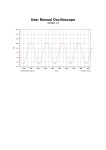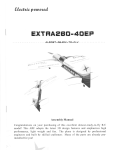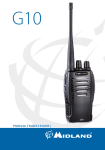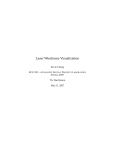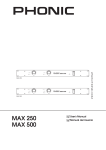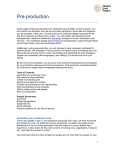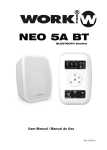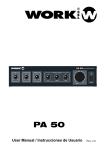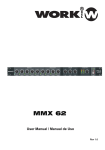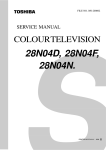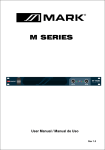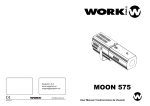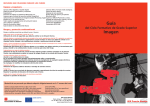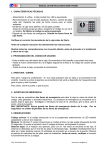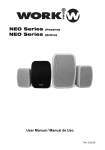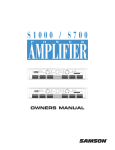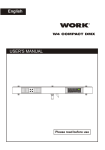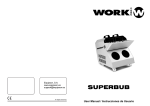Download MW 800 M - Manual
Transcript
MW 800 M MW 800 S User Manual / Manual de Uso Rev 1.0 EN 1. INTRODUCTION Thanks you for buying our excellent wireless microphone series. Before to use this product, please, read this Owner`s manual. For many reasons, such as low frequency, traditional wireless microphones systems are easy to be interfered especially because many devices like CD, VCD, etc radiate out too many harmonic. To solve this problem we design this kind professional wireless microphone. We adopt a series of measures to im prove its functions, advance frequency, using multilevel high frequency and mid frequency narrow band filter, multiple noise detect and control. We also design its special functions (tone key locked identity) to avoid interference from outside. 2. MAIN FUCTION - Using VHF band to over interferencing frequency. - Voltage indicating circuit in the microphone. It can tell you if it is necessary to change the battery. - A specially designed circuit switch on the microphone in order to clear up waves of miscellaneous signals. - It uses quart zcrystal oscillating circuits, so the frequency is very steady. - Audio compressing-expanding technology, the unit can lower noises and increase the dynamic range. It can also lower re-echo. - Particular noise detect to avoid interference from outside open the mute system. - Longest distance in open: 80 m. Idealist distance in open: 40 m. - It is suitable for stages, classroom, etc. 3. USING THE RECEIVER - Pullout antenna, make them be perpendicular with the device. - Connect to DC 15-17V socket using the included external power supply. - Audio output connection: One end of th3e audio cable into “AUDIO OUT” socket and other end into “MIX IN” or “AUX IN” of your amplifier or mixer device. - Push the power switch, the power indicating light will lit. - When the microphone is working, the “RF” LED lits. The receiver output volume can be controlled by adjusting the volume knob. ATTENTION! Before installing the receiver: - It should be more than 1m high from the floor. - It should be more than 1m beyond the wall. - Antenna should be put out fully, otherwise it will be influenced by other signals. - Avoid placing the device in a blind angle when it is used. - Do not throw fall, cast or toss the handling microphone, it can be damaged seriously. - Keep the unit apart from direct sunshine, rain or magnetic fields. - Do not open or repair the unit yourself. Please contact with distributor 1 User Manual/Manual de Uso MW 800 M/S EN 4. USING THE MICROPHONE - Open the battery cover and insert 2x 1.5V batteries. ATTENTION! The polarity should be right - Turn on the microphone. If the light does not twikle or is always lighted, check the batteries if the voltage is enough or they are well arranged. - Turn the mute switch to middle, the receiver will cut out audio output. 5. CONTROLS & FUNCTIONS RECEIVER 1. Power Switch 2. Power supply indicator 3. RF signal indicator 4. AF signal indicator 5. Volume control 6. Antenna 7. Audio output 8. Power input BODYPACK TRANSMITTER 1. Tie microphone 6. Antenna 7. Adjustable gain control 2. Input jack 3. Power indicator 8. Squelch adjust 9. Battery receptacle 4. Power switch 10. Battery cover 5. Volume adjust MICROPHONE 1. Grille 2. Power/Low indicator 3. Power and audio MUTE switch 4. Battery receptacle 5. Battery cover 2 User Manual/Manual de Uso MW 800 M/S EN 6. SPECIFICATIONS General Carrier Frequency: Frequency Estabilization: Dynamic Range: Total Harmonic distortion: Frequency response: Audio Output level: VHF Band < +/- 30 ppm > than 90 dB < than 0.8% 40 Hz - 15 kHz +/- 3dB 400 mV Balance/Unbalance Receiver Power Supply: Consumption: Signal/noise ratio: Image & Spurious rejection: Border upon channel rejection: Receiving sensitivity: De-Emphasis: Dimensions: Weight 10-17V DC (external power supply included) 4W > than 90 dB > than 80 dB > than 80 dB 4 dBuV (SINAD=20dB) 50 uS 150 x 100 x 30 mm 360 g Transmitter Transmitter power: Modulation Type: Max. Deviation: Spurious emission: Battery voltage: Continuous using: Dimensions: Weight: 10mW FM +/- 20 kHz > than 40 dB (With carrier) 2x 1.5V 6 hours approx. 260 mm (hand mic) 80 x 60 x 20 mm (bodypack) 80 g (hand mic) 140g (bodypack) 7. TROUBLESHOOTING 1. Turn on the receiver, but the indicator is not lighted - Make sure if the power cable is well fixed. Is the socket in good conditions?. Is the fuse blown?. 2. When you speak, the "AUDIO" LED twinkles but no sound output - Make sure if the volume keep in lowest place, or the audio cable is not fixed well. 3. The effective signal receiving distance becomes close and signal receiving is not well. - Perhaps you should change the batteries - Perhaps the receiver is not put in right place - Perhaps there is a strong magnetic field in your surrounding 4. Timbre becomes bad. - Perhaps the voltage of the batteries is not enough. You need to change them. - Perhaps there are the same frequency singal in your surrounding. Do not usetwo devices with the same frequency at the same time in a place. (Separate them at least 100m) 3 User Manual/Manual de Uso MW 800 M/S ES 1. INTRODUCCION Gracias por la adquisición de este excelente sistema de microfonía inalámbrica. Antes de usar este producto, por favor, lea el manual de instrucciones. Por muchas razones, como una baja frecuencia, los sistemas de microfonía inalámbrica sufren interferencias debido a que dispositivos como CD, VCD. etc radian muchos armónicos. Para solucionar este problema, hemos diseñado este tipo de micrófono inalámbrico profesional. Hemos adaptado una serie de medidas para mejoras sus funciones, control avanzado de frecuencia, filtro de banda estrecha y detección y control de ruido múltiple. Además hemos incorporado funciones especiales (bloque de tono para evitar interferencias externas. 2. FUNCIONES PRINCIPALES - Uso de la banda VHF para evitar interferencias de frecuencia.. - Circuito de indicación de voltaje en el micrófono que avisa cuando es necesario cambiar las pilas. - Circuito de conmutación especialmente diseñado en el micrófono para eliminar frecuencias espúreas. - Utiliza circuitería de oscilación con cristal de cuarzo para una mejor estabilidad. - Tecnología de auto compresión/expansión, la unidad puede reducir el ruido y aumentar el rango dinámico. También puede reducir el eco. - Detector de ruido para evitar interferencias externas. - Máxima distancia en campo abierto: 80 m. distancia ideal en campo abierto: 40 m. - Adecuado para escenarios, escuelas, etc. 3. USANDO EL RECEPTOR - Coloque la antena perpendicular con el dispositivo. - Conecte la clavija del alimentador DC 15-17V incorporado. - Conexión de salida de audio: Un lado del cable de audio e la toma “AUDIO OUT” y el otro lado en la toma “MIX IN” o “AUX IN” de su dispositivo mezclador o amplificador. - Pulse el interruptor de encendido, el indicador power se encenderá. - Cuando el micrófono funciona, el LED “RF” se ilumina. El volumen de salida del receptor puede ser ajustado controlando el mando de volumen. ATENCION! Antes de instalar el receptor: - Debe estar a más de 1m de altura del suelo. - Debe estar a más de 1m de las paredes. - La antena debe estar totalmente desplegada para no verse influenciada por otras señales. - Evite colocar el dispositivo en un ángulo ciego. - No lance o deje caer el micrófono, podría dañarse seriamente. - Mantenga la unidad apartada de la luz solar directa, lluvia o campos magnéticos. - No abra o trate de reparar la unidad usted mismo, contacte con su distribuidor 4 User Manual/Manual de Uso MW 800 M/S ES 4. USANDO EL MICRÓFONO - Abra la cubierta de las pilas e inserte 2 de 1.5V ATENCION! La polaridad debe ser correcta - Encienda el micrófono. Si el LED no parpadea o está siempre encendido. Compruebe las pilas por si el voltaje no fuera suficiente. - Pase el conmutador mute a la posición central, el receptor cortará salida de audio. 5. CONTROLES y FUNCIONES RECEPTOR 1. Interruptor de encendido 2. Indicador de alimentación 3. Indicador de señal RF 4. Indicador de señal AF 5. Control de volumen 6. Antena 7. Salida de audio 8. Entrada de alimentación MICROFONO 1. Rejilla 2. Indicador encend/baja bat. 3. Power and audio MUTE switch 4. Portapilas 5. Tapa EMISOR DE PETACA 1. Micrófono de solapa 2. Conector de entrada 3. Indicador de aliment. 4. Conmut. de encendido 5. ajuste de volumen 5 6. Antena 7. Ajust. ganancia 8. Ajust. Squelch 9. Portapilas 10. Tapa User Manual/Manual de Uso MW 800 M/S ES 6. ESPECIFICACIONES General Frecuencia Portadora: Estabilizacionde la frecuencia: rango Dinámico: Distorsión armónica: Respuesta en frecuencia: Nivel de salida de audio: Banda VHF < +/- 30 ppm > 90 dB < 0.8% 40 Hz - 15 kHz +/- 3dB 400 mV Bal./Desbal. Receptor Alimentnación: Consumo: Relación señal/ruido: Rechazo imagen y frec. espúreas: Umbral de canal de rechazo: Sensibilidad de recepción: De-Emphasis: Dimensiones: Peso: 10-17V DC (alimentador externo incluido) 4W > 90 dB > 80 dB > 80 dB 4 dBuV (SINAD=20dB) 50 uS 150 x 100 x 30 mm 360 g Emisor Potencia: Tipo de modulación: Desviación máxima: Emisiones espúreas: Alimentación pilas: Uso contínuo: Dimensiones: Peso: 10mW FM +/- 20 kHz > 40 dB (con portadora) 2x 1.5V 6 horas aprox. 260 mm (micro mano) 80 x 60 x 20 mm (petaca) 80 g (micro mano) 140g (petaca) 7. RESOLUCION DE PROBLEMAS 1. Se conecta el receptor pero el indicador no se ilumina - Asegúrese que el cable está bien fijado. Está el conector en buenas condiciones?. Está fundido el fusible? 2. Al hablar, el LED "AUDIO" parpadea pero no hay sonido - Compruebe si el volumen está al mínimo o el cable de audio no está fijado adecuadamente. 3. La distancia efectiva de recpeción es muy reducida y la señal no se recibe bien - Tal vez deba cambiar las pilas. - El receptor no está situado en la posición más idónea. - Hay un fuerte campo magnético en las cercanías. 4. El timbre no es bueno. - Tal vez el voltaje de las pilas no es suficiente y necesite cambiarlas. - Hay un dispositivo en las cercanías con la misma frecuencia de señal. No use dos dispositivos con la misma frecuencia a la vez en el mismo lugar (Sepárelos al menos 100m) 6 User Manual/Manual de Uso MW 800 M/S This symbol on the product or on its packaging indicates that this product shall not be treated as household waste. Instead it shall be handed over to the applicable collection point for the recycling of electrical an electronic equipment. By ensuring this product is disposed of correctly, you will help prevent potential negative consequences for the environment and human health, which could otherwise be caused by inappropriate waste handling of this product. The recycling of materials will help to conserve natural resources. For more detailed information about recycling of this product, please contact your local city office, your household waste disposal service or the shop where you purchased the product. Manufactured by EQUIPSON, S.A. http://www.equipson.es








